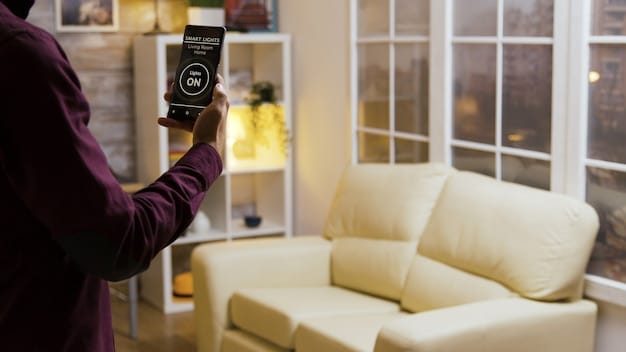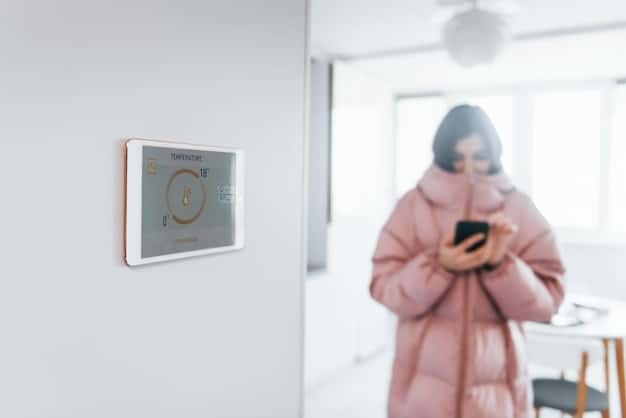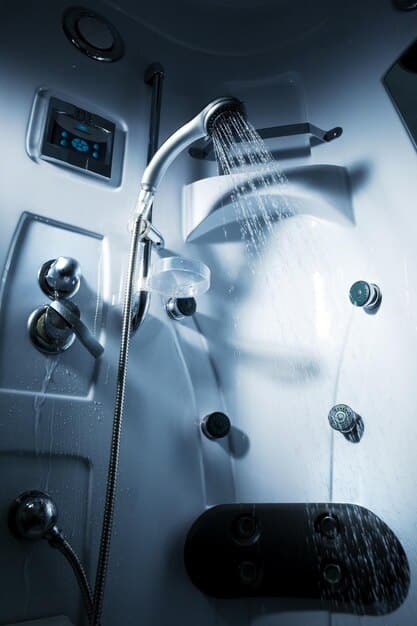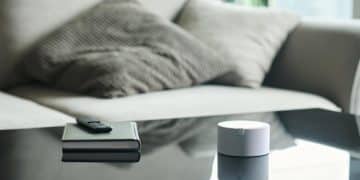5 Smart Home Upgrades That Pay You Back Fast

Smart home upgrades can seem expensive, but some quickly pay for themselves through energy savings and increased home value, often in under three years.
Investing in your home doesn’t always have to feel like a money pit. Some 5 smart home upgrades that pay for themselves in under 3 years not only enhance your living experience but also offer impressive returns on investment through reduced bills and increased property value.
Smart Thermostats for Energy Efficiency
Smart thermostats have revolutionized home climate control. They learn your habits and adjust temperatures automatically, ensuring optimal comfort while minimizing energy waste.
How Smart Thermostats Work
Smart thermostats connect to your home’s Wi-Fi network, allowing you to control your heating and cooling systems remotely via a smartphone app. They use sensors to detect occupancy and temperature, and they can be programmed with personalized schedules.
- Learning Capabilities: Smart thermostats learn your preferred temperature settings and adjust automatically, optimizing energy usage.
- Remote Control: Control your thermostat from anywhere with your smartphone or tablet, ensuring your home is comfortable when you arrive.
- Energy Reports: Track your energy consumption and identify areas where you can save money on your bills.
- Geofencing: Set your thermostat to adjust automatically when you leave or approach your home, saving energy when you’re away.

By accurately managing your home’s temperature, smart thermostats can significantly reduce your energy consumption. This not only helps the environment but also puts money back in your pocket.
LED Lighting for Long-Term Savings
Switching to LED lighting is one of the simplest and most effective smart home upgrades. LED bulbs use significantly less energy than traditional incandescent bulbs and last much longer.
LED lighting offers a compelling combination of energy efficiency, longevity, and performance. By making the switch, homeowners can enjoy reduced energy bills, lower maintenance costs, and improved lighting quality.
Benefits of LED Lighting
LEDs offer several advantages over traditional lighting options, making them a smart choice for homeowners looking to save money and reduce their environmental impact.
- Energy Efficiency: LEDs use up to 75% less energy than incandescent bulbs.
- Long Lifespan: LEDs can last up to 25 times longer than traditional bulbs.
- Durability: LEDs are resistant to shock and vibration, making them ideal for various applications.
- Improved Lighting Quality: LEDs provide bright, consistent light without flickering or buzzing.
Replacing your old bulbs with LEDs is a practical step towards energy conservation, reducing your carbon footprint, and saving money in the long run.
Smart Plugs for Phantom Load Reduction
Many electronic devices continue to draw power even when they’re turned off. This “phantom load” can add up over time, increasing your energy bills. Smart plugs can help you eliminate this waste.
How Smart Plugs Work
Smart plugs plug into existing outlets and offer remote control through a smartphone app. They can be programmed to turn devices on and off at scheduled times, or they can be controlled manually from anywhere.
Smart plugs help by stopping the bleed of excessive energy consumption of your devices from standby mode when you are not using them.
- Remote Control: Turn devices on and off from anywhere with your smartphone or tablet.
- Scheduling: Set timers to automatically turn devices on and off.
- Energy Monitoring: Track energy consumption and identify devices that are wasting power.
- Voice Control: Integrate smart plugs with voice assistants like Amazon Alexa or Google Assistant for hands-free control.
By using smart plugs to control your devices, you can eliminate phantom loads and save money on your electricity bills. It’s a simple and effective way to reduce your energy consumption.
Low-Flow Showerheads and Faucets for Water Conservation
Water conservation is not only good for the environment, but it can also save you money on your water bill. Low-flow showerheads and faucets reduce water consumption without sacrificing water pressure.
These offer a sustainable solution to resource management, allowing households to maintain their quality of life, save on consumption costs, and contribute to environmental preservation.

Benefits of Low-Flow Fixtures
Low-flow showerheads and faucets use less water than traditional fixtures, helping you conserve this precious resource and reduce your water bill.
How much will it save you?
- Reduced Water Consumption: Use less water without sacrificing water pressure.
- Lower Water Bills: Save money on your monthly water bill.
- Environmental Benefits: Conserve water and reduce your environmental impact.
- Easy Installation: Low-flow fixtures are easy to install and can be done yourself.
Installing low-flow showerheads and faucets is a practical and eco-friendly way to conserve water and save money. It’s a win-win for both your wallet and the environment.
Smart Irrigation Systems for Efficient Watering
If you have a lawn or garden, a smart irrigation system can help you save water by automatically adjusting watering schedules based on weather conditions and soil moisture levels.
They offer a smart approach that not only optimizes resource utilization but also contributes significantly to financial savings and sustainable environmental practices.
How Smart Irrigation Systems Work
Smart irrigation systems use sensors and weather data to determine the optimal amount of water needed for your lawn and garden. They can be programmed to water only when necessary, preventing water waste.
Watering your garden without precision and control can cost you more than you imagined.
- Weather Data Integration: Adjust watering schedules based on real-time weather data.
- Soil Moisture Sensors: Monitor soil moisture levels and water only when needed.
- Remote Control: Control your irrigation system from anywhere with your smartphone or tablet.
- Customizable Schedules: Create personalized watering schedules based on your plants’ specific needs.
By using a smart irrigation system, you can ensure your lawn and garden are watered efficiently, saving you money and conserving water. It’s a smart investment for any homeowner with outdoor spaces.
| Key Upgrade | Brief Description |
|---|---|
| 💡 Smart Thermostat | Optimizes heating/cooling for energy savings. |
| 🔆 LED Lighting | Energy-efficient bulbs with long lifespan. |
| 🔌 Smart Plugs | Reduces phantom energy loads of unused devices. |
| 🚿 Low-Flow Fixtures | Conserves water without affecting water pressure. |
Frequently Asked Questions
▼
A smart thermostat can often pay for itself in energy savings within one to two years, depending on usage and local energy costs.
▼
Yes, LED bulbs use significantly less energy and have a much longer lifespan than traditional bulbs, saving you money on electricity bills and replacements.
▼
Yes, smart plugs can help eliminate phantom energy loads, reducing energy waste and lowering your electricity bill over time.
▼
Low-flow showerheads restrict the amount of water used per minute without sacrificing water pressure, saving you water and lowering your water bill.
▼
While some installations might require professional help, many smart irrigation systems are designed for easy DIY installation with clear instructions.
Conclusion
Investing in smart home upgrades is a practical approach to enhancing your living space while also reducing your expenses. Whether it’s through energy savings, water conservation, or increased home value, these upgrades offer long-term benefits that make them worthwhile investments for any homeowner.





